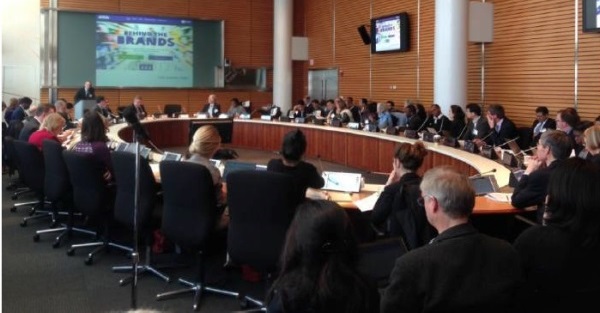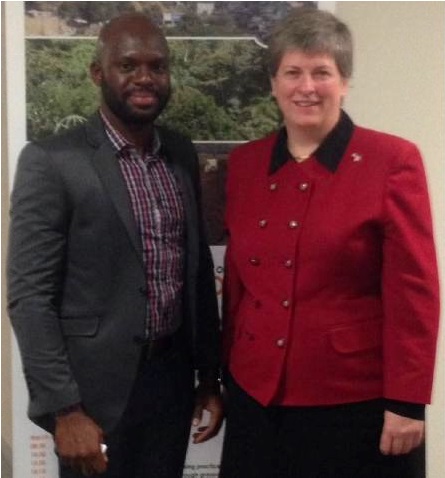News in 2014

|
Report on the 2014 World Bank Conference on Land and Poverty
24-28 Marts 2014, Washington DC, USA
A Report by Jamal Browne
This document is a brief outline of my involvement in the
2014 World Bank Conference on Land and Poverty, held at the bank’s
headquarters in Washington DC, March 24 - 28. It has been prepared for The
Board of Trustees of the Aubrey Barker Fund and the International Federation
of Surveyors (FIG) Foundation.

The 2014 World Bank Conference on Land and Poverty was
nothing short of a resounding success. It indeed exceeded my already high
expectations, and was truly worth every ounce of my sponsors’ investments.
On the note of my sponsors, let me first of all say a
heartfelt thanks to The International Federation of Surveyors (FIG)
Foundation, The Aubrey Barker Fund, and The University of the West Indies
St. Augustine for affording me this opportunity. These words are not
sufficient an expression of my gratitude to each organization, but I do hope
that the following outline of my keen involvement in this year’s conference
serves as adequate reprisal for such significant investments.
PRESENTATION 1 – MISSION ACCOMPLISHED
I had the privilege of making two presentations at this
year’s conference; the first of which was based on my ongoing doctoral
research, with the other following the general theme of the conference’s
Youth Strategy Session – ‘Positioning Youth in the Post-2015 Land and
Development Agenda’.
Presenting alongside the likes of Dr. Catherine Courtney of Tetra
Tech Ltd, Kathleen Fitzgerald of The African Wildlife Foundation, and
Policy and Legal Reform expert Caleb Stephens, was indeed a great
honour. Our session’s chair, Mr. Robert Buergenthal – Senior Director
of International Strategy at Thomson Reuters USA – delivered exceptionally
on his assignment.
Our session, which followed the theme ‘Communal Level Property Rights in the
Face of Risk Management’ was extremely well organized – an accomplishment
very much attributable to Mr. Buergenthal’s early preparatory work
(having initiated pre-conference email conversations with each presenter).
The focus of my first presentation was ‘The Investigation of Variations in
Social Tenure Forms as a Basis for Hazard Vulnerability Indexing’. Therein I
sought to show how different types of land tenure are associated with
different levels of hazard vulnerability, how this understanding allows for
the development of a hazard vulnerability index, and how this advances the
current understanding of ‘The Continuum of Land Rights’.
Interestingly, the latter objective was largely inspired by a discussion at
the 2013 conference on the way forward for ‘The Continuum’. I have since
then been motivated to further investigate the utility of the continuum, and
have since developed a prototype vulnerability framework that allows us to
rank land tenure forms based on the associated levels of hazard
vulnerability.
I had previously dreaded the idea of presenting on the conference’s opening
day. However, considering the applause, encouragement and extremely useful
advice offered at the end of my delivery and in subsequent post-session
private conversations, I could not ask for a better confidence booster. It
was truly the perfect start to a much anticipated week.

Jamal Browne (Center) with session chair Mr. Robert Buergenthal (far right)
and fellow presenters immediately following their session on ‘Communal Level
Property Rights in the Face of Risk Management’.
PRESENTATION 2 – YOUTH, LAND & THE POST-2015 AGENDA
My second presentation focused on the collection of
youth-responsive disaggregated data on land, and was delivered on Tuesday
March 25th. Following the general theme of the session, ‘Positioning Youth
in the Post-2015 Land and Development Agenda’, I sought to illustrate how
contemporary and future efforts at addressing the issue of youth access to
land is highly dependent on constantly shifting priorities of young
individuals cross regions and cultures. It is on this premise that I offered
justification for the collection and use of disaggregated data on such
issues in support of a new youth-responsive global land agenda.
My fellow presenters included:
Eva-Maria Unger of the International
Federation of Surveyors Young Surveyors Network; Primoz Kovacic,
Co-Founder of Spatial Collective; and Steven Jonckheere of IFAD.
Discussants included: Kysseline Cherestal of ActionAid USA; Jack
Makau of Slum Dwellers International; Susana Rojas-Williams of
Habitat for Humanity; and Sosina Besu of The Norwegian University of
Life Sciences.
This session served as a useful high-level youth and land forum where urgent
issues related to rural-urban youth migration, livelihood challenges of
youth within the land sector, and youth access to land in small-island
developing states were discussed. Also highlighted were projects currently
being undertaken by various international organizations and social-corporate
entities all across the globe. It is anticipated that the 2015 World Bank
Conference on Land and Poverty would incorporate a special plenary session
on ‘Youth and Land’, thus building on those issues highlighted at this
year’s Youth Strategy Session.
CONFERENCE OVERVIEW
Having participated in the 2013 conference, there were
several notable improvements to the general workings of the week-long event.
However, the greatest improvement by my estimation may have been what I
perceived to have been a shift from an overly-academic to a more applied
approach to the majority of the open sessions that I had the opportunity of
attending.
In light of the highly topical nature of the overall theme of the conference
– ‘Integrating Land Governance into the Post-2015 Agenda’ – and with over 90
parallel open sessions, my approach was simply to attend those forums that I
considered most relatable to land-related issues in the Caribbean Community
(CARICOM), my ongoing PhD research, and my professional networking strategy.
Some of the more pertinent subjects therefore included:
-
Capacity building for improved land administration
-
Integrating land governance in the post-2015 framework
-
Ensuring good governance in public land management
-
Interventions to foster responsible land-based investment
-
Housing
The highpoints of this year’s conference were two closed
sessions – one of which I had the privilege of attending – held at the
bank’s headquarters on Friday, March 28th. The Conference’s Expert Group
Meeting [EGM] and the Joint International Federation of Surveyors [FIG] /
World Bank Spatial Innovation and Good Practices in Land Administration
Forum both offered new benchmarks and key considerations in proceeding with
the Post-2015 Development Agenda. The Joint FIG / World Bank Forum saw the
launch of a new publication – ‘Fit-For-Purpose Land Administration’ – that
offers what lead author Professor Stig Enemark considers “…a human
rights approach…” to the management of current land issues within a specific
country or region. Another notable achievement was the EGM’s proposal for a
land and tenure-related target – subject to further empirical work – for the
Post-2015 Development Agenda, which states: “Increase by XX% the number of
women and the number of men who have secure tenure of land, property and
natural resources that support their well-being and livelihoods.”
This year’s conference offered a wealth of networking opportunities – from
pre-arranged meetings and informal caucuses with senior geospatial, land
administration, and rural development officials from various international
organizations and leading corporate entities, to lunch-time and gala
discussions on global land issues with postgraduate students and interns
from all across the globe. It was nothing shy of an idyllic experience, and
I am now inspired to become even more involved in the ongoing global
conversations on the post-2015 global land agenda.

Following the special Joint FIG/ World Bank Spatial Innovation and Good
Practices in Land Administration Forum, I was offered the opportunity to
converse with Keynote Speaker Dr. Vanessa Lawrence – Director General and
Chief Executive of Ordinance Survey, and Co-Chair of the UNGGIM Committee of
Experts. It was indeed a great honour, and I would forever cherish the
advice offered by this stalwart of our noble profession.
With Gratitude
Jamal A.V. Browne
15 April 2014
|


























